Key in a search term below to search our website.
Key in a search term below to search our website.
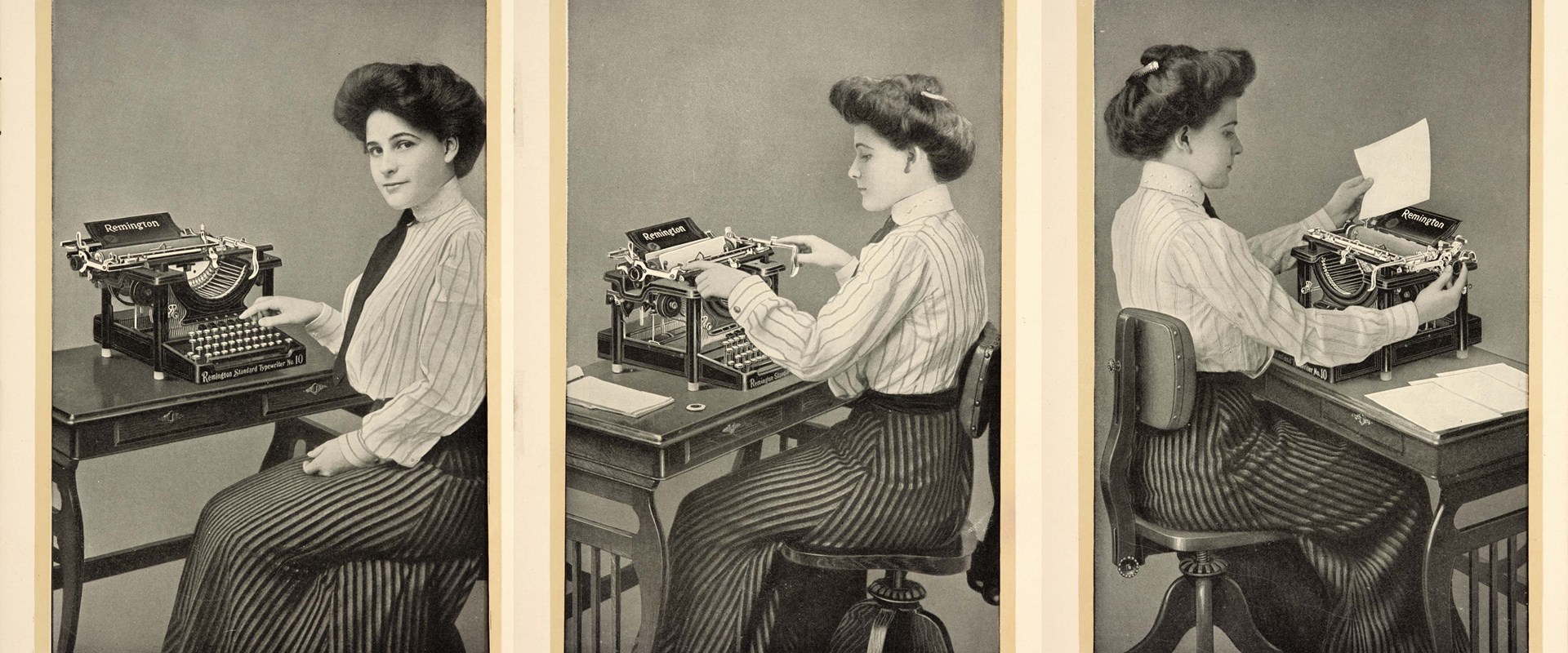
The introduction of the typewriter in the workplace had a huge impact on the role of women, both positive and negative. From its introduction in the 19th century, it created new opportunities for women in business, as employers and employees, and changed the way women would work forever.
The typewriter appeared in the latter half of the 19th century alongside massive changes in society and industry. The Industrial Revolution had paved the way for increasing dominance of big business, fundamentally changing ways of working, with a big increase in bureaucracy. All of that needed to be documented and processed.
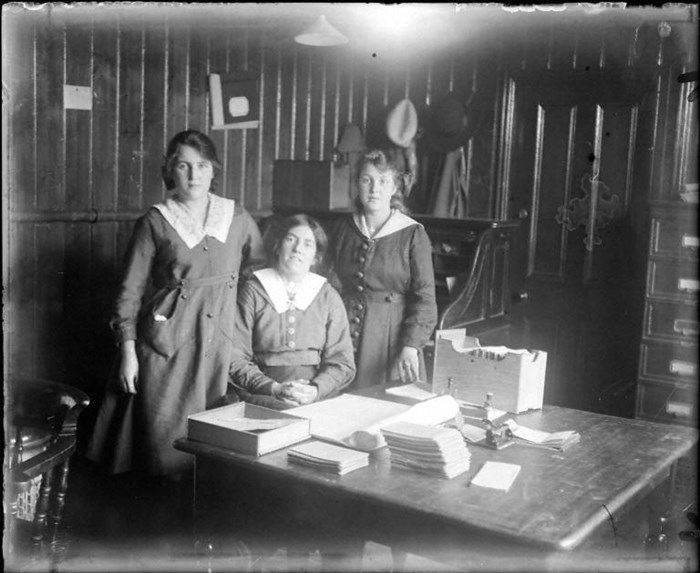
Women clerical workers in an office in Greenock, c.1915.
The role of the office clerk had traditionally been a man's occupation. Clerks created records and generated correspondence, all of it handwritten, for their employers. Charles Dickens created the character of Bob Cratchit, a typical office clerk of the time for his novel, A Christmas Carol. With the emergence of the typewriter and the requirement for documents to be created more quickly, the role of the typist was born.
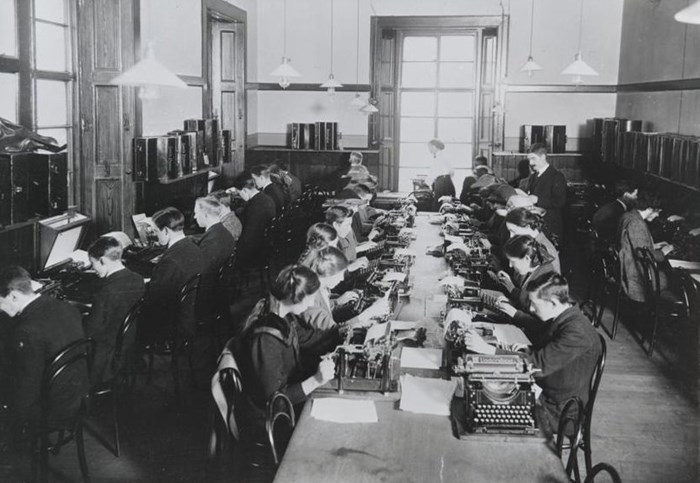
Typewriting class at the Royal High School.
During the First World War, so many men left to fight on the front that their jobs had to be filled by women. For the first time, many more women were involved in jobs usually carried out by men, including heavy industry and office work.
The role of the typist was seen as a suitable type of work for women as it didn't take roles away from men. It provided work for the educated middle-class woman who hadn't traditionally worked. Later it provided an option for working-class girls who had done well at school.
Typing provided women with the potential for greater financial independence and the opportunity for entrepreneurial women and those with funds to set up their own businesses where they trained and employed others.
To meet the need for typists, typing schools opened where students would also learn shorthand and bookkeeping. By 1901, 99% of typists in Scotland were women. While men also used typewriters, they did not think of themselves as typists. As a less well-paid job, there was often an assumption that typing didn't require a lot of knowledge or skill. A perception far from the truth!
The knowledge required by typists was enormous and they had to know all about different areas of business and other subjects. There was a lot more to being a typist than simply copying something. They needed a very broad skill base and were often fluent in several languages.
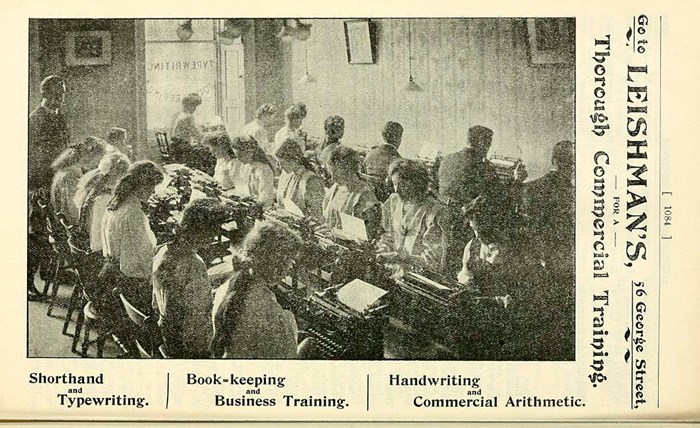
Advert for one of Edinburgh's typing schools in the Post Office Edinburgh & Leith directory 1910-11, from the National Library of Scotland's Scottish Post Office Directories collection.
One woman who took advantage of the opportunities offered by the introduction of typewriters was Ethelinda Hadwen. The daughter of a cotton mill owner, Ethelinda was born in Lancashire in 1863. In her teens, she studied in Paris and, after returning to the UK in 1886, she opened a typewriting office in Edinburgh with her business partner Elizabeth Fleming.
The office provided typing services to local firms and was the first of its kind in Scotland. The average typewriter office would employ four or five people, normally women, and would cater to businesses, banks, lawyers, authors, architects and professors who needed all manner of things typed or translated.
Typewriting offices were often managed by women. These were businesses where women weren't just workers but, unusually for the time, were also employers.
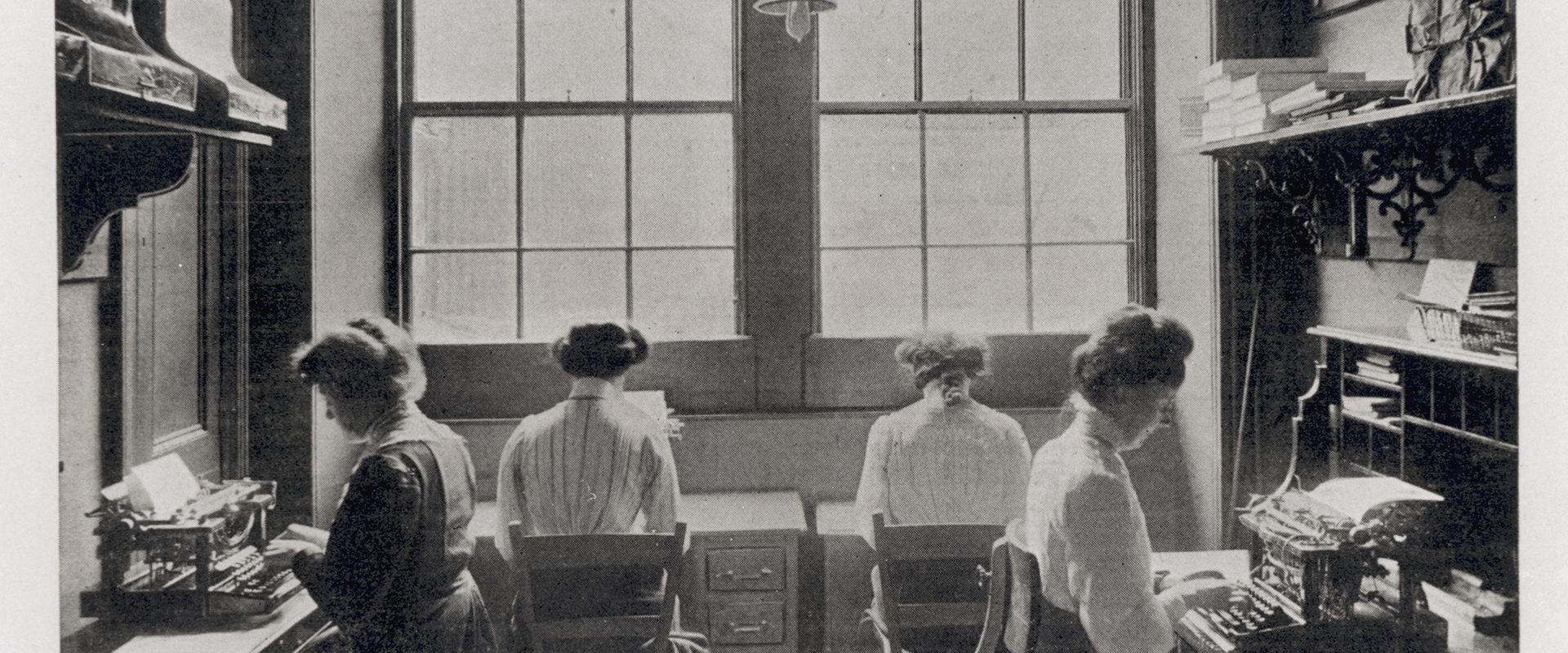
Women at work in a typing office © Aberdeen City Council.
Through these women-led firms, the typewriter also played a part in advancing the campaign to give women the vote. Ethelinda Hadwen became a leading member of the Edinburgh branch of the National Society for Women's Suffrage.
As more and more women proved they could run businesses as well as any man, it weakened some of the arguments that were often made against them being given the vote.
There was also a drive to see more women elected onto parish councils and school boards, demonstrating their ability to hold public offices, and Ethelinda became a member of Edinburgh City Parish Council.
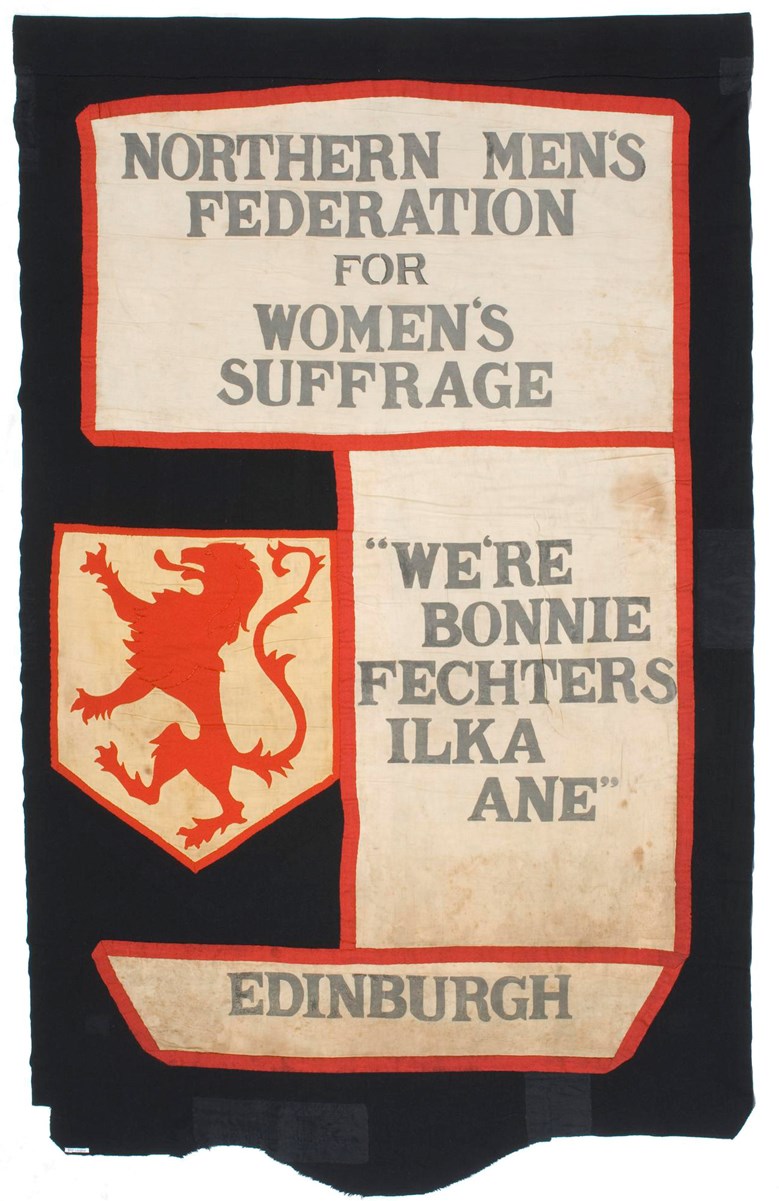
Processional Suffragette banner for the Northern Men's Federation of Women's Suffrage (A.1991.68).
In 1898, Hadwen was reported in the Woman’s Signal: "Speaking of her own recent candidature for the Parish Council, she said she had proved the error of the idea that women would find going into the turmoil of an election or of political life extremely disagreeable, and that it would tend to rob them of their refinement, of their domestic qualities, and of everything, in fact, that made women amiable."
In 1906, Ethelinda was elected to the Edinburgh School Board after a campaign in which she capitalised on her twenty years of business experience in the typewriting sector. Before addressing a meeting of electors at Regent Road School, Hadwen was introduced as "a business lady" who was "well qualified to be a member of the School Board."
As Hadwen’s life shows, there was clearly a link between the suffragettes and the power of the typewriter. It was both a tool for campaigning and one of the key technologies associated with women going into the workplace and moving into the public sphere.
Our Typewriter Revolution exhibition's principal curator, Alison Taubman, talked to Chloe Tilley on Woman's Hour about how typewriters provided a key opening into the world of work, propelled women into the public sphere, and played a major role in the fight for women's suffrage.
Listen hereIn 1904, Ethelinda donated a Sholes & Glidden machine to our collections. At that time, it would have been too out of date to have been used in her business, but its decoration and design marked it out as an object worthy of preserving.
Developed by Christopher Latham Sholes and Carlos Glidden, the Sholes & Glidden typewriter was made by E. Remington & Sons. It was the first typewriter to feature the QWERTY keyboard. There was no shift key, meaning it printed capitals only.
From the 1890s, female typists were seen as representative of the 'New Woman', a term used at the time to describe educated and financially independent women. The New Woman typist was a character in popular fiction from the turn of the 20th century and was surrounded by positive and negative stereotypes in the public imagination.
The ‘typewriter girl’ was portrayed in unflattering depictions in books and films which reflected little of the reality of typists’ lives. The stereotype of the new young woman who has financial independence became a part of the public imagination, and not always in a positive way.
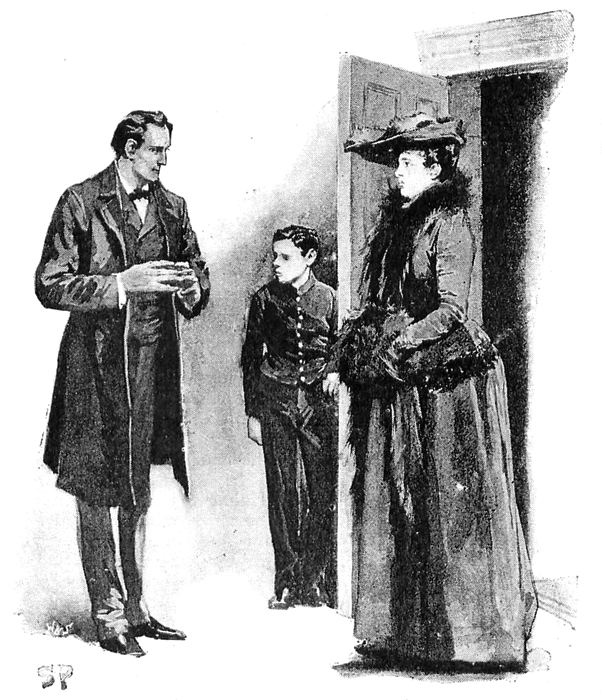
Illustration by Sidney Paget from A Case of Identity by Sherlock Holmes, 1891.
Arthur Conan Doyle featured a typist in his 1891 Sherlock Holmes story, A Case of Identity. Mary Sutherland consults the famous detective over a missing fiancé. A typewriter is key to solving her case. Conan Doyle is believed to be the first author to use the typewriter as a plot device. Holmes works out that a particular typewriter was used to write a specific letter by looking at the idiosyncrasies of the machine. Unfortunately, Mary Sutherland is shown as a character with little substance.
The positive impact a typewriter could have on a woman’s life was also highlighted in literary works. The Twelve-Pound Look, by Peter Pan creator JM Barrie, told the story of a woman who was able to leave her arrogant husband and support herself because she saved up to buy a typewriter.
There were other positive representations of typists, including the independent and resourceful Mina Murray in Bram Stoker’s 1897 story Dracula and the 1903 novel The Girl.

Betty McLeish working at her desk at the Edinburgh Press, 1915-1936 from the Scottish Life Archive.
The introduction of the typewriter enabled women to enter the world of business. But it also inadvertently defined a role, that of the typist/secretary, that was paid much less than the male clerks they replaced.
Until the Equal Pay Act 1970, the pay of women compared to men in similar roles was much less. The idea of a source of cheap labour was attractive to employers and women could be employed at half the price for doing similar work. Historically, types of jobs associated with women ("women's work", such as domestic, administrative or care work) were or became lower-paid jobs. One example going the other way is computer programmer: once seen as low-paid women's work akin to typing, when punch-card systems were in place, it became increasingly well paid as men began to enter the field.
While the Equal Pay Act 1970 and the Equality Act 2010 improved matters, ensuring men and women are paid equally for the same work, a gender pay gap continues to exist, especially at more senior levels. Today, organisations may try to tackle this pay gap by offering more flexibility in working roles. They should also, as the history of typewriters helps show, be alert to assumptions about the value of different kinds of work.
Header image: Miss Remington explains the new Model 10', from a leaflet dating from around 1908.